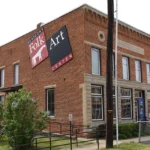
The University of New Orleans may sunset an influential MFA program that for decades has provided an affordable and accessible training ground for local visual artists.
Last week, students pursuing a Masters of Fine Arts in visual arts were told the program would be phased out because of low enrollment. Current students can finish their degrees, faculty were told, but the university rescinded offers it had made to a handful of students who were set to begin this fall.
News of the program’s possible end has sparked an outcry among faculty, students and the greater New Orleans arts community. An online petition urging UNO leaders to reconsider the decision garnered hundreds of signatures.
“This is cultural devastation for the people who can’t afford to go to Tulane and for the people who can’t afford to leave home,” said Cheryl Hayes, a professor emeritus who received a fine arts undergraduate degree and MFA from UNO. Hayes retired from full-time teaching at UNO after decades with the fine arts department.
Darrell Kruger, provost and senior vice president for academic affairs at UNO, said in a statement that the university has not yet decided the fate of the program but is assessing its “long-term viability” after years of low enrollment and completion rates.
As students and faculty wait for answers, some see the program as a casualty of recent upheaval at the university. Over the last year, UNO has furloughed and laid off staff, closed buildings, merged colleges and enacted a spending freeze to reduce a major deficit. Now, state lawmakers are considering putting the university under the oversight of the LSU system.
University officials have kept mum about what the change would mean for UNO but some students and faculty have speculated it could involve eliminating some programs — and that the MFA program’s fate could be a sign of what’s to come.
Affordable access to arts education
UNO’s MFA in visual arts is the only program of its kind at a public New Orleans institution. (Tulane University offers a smaller MFA program with higher tuition.) Many fear the closure of UNO’s program would substantially limit affordable opportunities for artists to pursue an MFA, the terminal degree in fine arts.
Hayes, the UNO professor, said there would be fewer artists from less privileged backgrounds influencing the arts in New Orleans.
“They won’t be at the galleries on Julia Street because they won’t exist anymore,” she said. “They won’t be at the collective and experimental galleries on St. Claude anymore. They won’t be teaching.”
Though the program attracts unconventional students – including once an Icelandic fisherman – it also caters to Louisianans who often stay after graduation, filling local galleries with their work. Others have gone on to international acclaim.
Matt Beshears, a first-year MFA student who came to the program after working for more than 30 years in finance, turned down admission to the School of the Arts Institute of Chicago for UNO because “it’s ingrained in the arts community here in New Orleans.”
Despite signs that the program is underfunded – raccoons frequently visit the art department – he credited his professors with helping him hone his painting, printmaking and photography skills.
If the program were to close, Beshears said, “It’s a big chunk of the culture being lopped off.”
UNO’s off-campus gallery on St. Claude Avenue showcases the thesis projects of graduating MFA students each year as well as local, national and international artists.
Josiah Gagosian, a painter and sculptor who obtained his MFA from UNO in 2020, said he met his current gallerist at his thesis presentation at the St. Claude Gallery.
“It helps connect UNO to the community and connects New Orleans to the rest of the art world,” Gagosian said of the gallery. “Having that missing is going to be a loss for New Orleans.”
Garrett Richardson, a first-year MFA candidate and Lake Charles native, said the professors — all exhibiting artists — mentor and help students fine-tune their technical skills across different mediums.
The program has a “focus on making sure the art really says something that needs to be expressed,” he said.
Richardson said students were told they would be able to finish their degree at UNO or “other institutions.” With UNO’s pending shift to the LSU system, some fear the program could merge with LSU’s in Baton Rouge, which would exclude students who can’t move or regularly commute to Baton Rouge. UNO did not immediately respond to inquiries about that possibility.
Richardson, who specializes in painting, drawing and printmaking, said he was unsure whether he would be able to continue his degree if they shifted the program to LSU.
“That would essentially be like being told I can’t finish because New Orleans is my home,” he said. “If they cut the MFA, I worry UNO will become irrelevant in the arts scene in New Orleans.”
A plan for success?
For now, the fate of the program is tied up in a Board of Regents review process after it was among programs flagged by the board for its low “completion rate.”
Dan Rule, a fine arts professor at UNO since 2008, said the program has been flagged multiple times in the past but faculty have been able to successfully defend the program, which he explained is small because of its limited budget and studio space.
This time, fine arts department faculty did not have a say in the program’s defense, Rule said. The provost was going to recommend to the board of regents that the program be terminated and Chuck Taylor, the director of the School of the Arts, told faculty in a meeting that the program would not accept new applicants. But after faculty and social media pushback, faculty members have until May 16 to submit a new proposal for the program.
“Any termination of a program would begin at the institution level, if they choose to do so,” said Chris Yandle, a spokesperson for the Board of Regents.
In a statement, Kruger, the UNO provost, acknowledged the program’s contributions to the cultural life of the university and the city but said a decision about the program would consider UNO’s “academic mission” and “responsibility to steward public resources wisely.”
“Our focus remains on supporting current students and maintaining academic integrity as we assess the program’s long-term viability,” he said.
Faculty said cutting the program would not save the university much money. Fine arts department faculty aren’t compensated for their additional work with graduate students, Hayes said, and graduate students teach often-packed undergraduate courses in exchange for tuition waivers.
“We’ve winning on a shoestring — duct tape and bubble gum are holding it together and we’re still turning out the finest artists in the state,” Hayes said. “I don’t know what is to be gained by doing this.”











